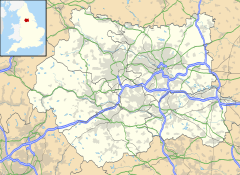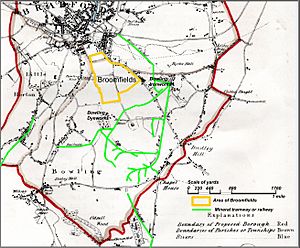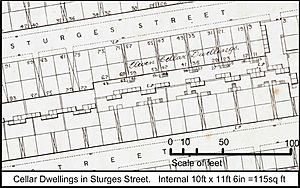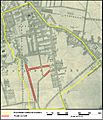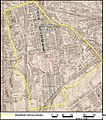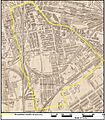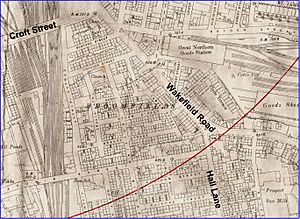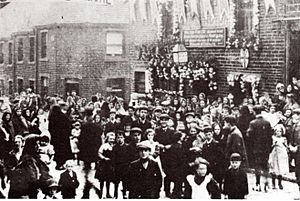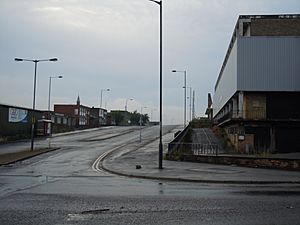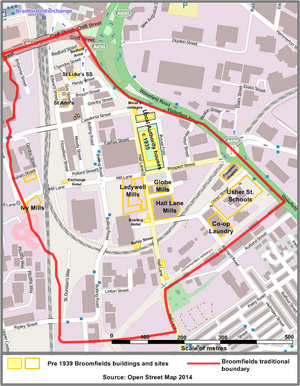Broomfields, Bradford facts for kids
Broomfields is a historic area on the southeast side of Bradford, West Yorkshire, England. In 1840, it was mostly countryside with only a few hundred people. By 1880, it had become a busy part of Bradford.
It was home to about 8,000 people living in 1,500 houses, plus many shops and businesses. In 1932, a plan began to clear old, poor-quality housing and rebuild the area for businesses. Today (2014), Broomfields is almost entirely commercial, with only about two hundred people living there.
Contents
Broomfields: Where it is and how it started
Broomfields was never an official town or district. It was more of a local name for a specific area. Most of Broomfields was in a place called Bowling. Its eastern border was Wakefield Road, and its western border was Manchester Road.
The name "Broomfields" came from the flowering broom plants that grew there. The land had thin, clay soil, which wasn't good for farming crops. Instead, it was used for grazing animals. People from Bradford used to enjoy walking in Broomfields and fishing in the streams.
The area also had a special spring called Lady Well. Its water was thought to have healing powers, and people visited it on holidays. Things started to change slowly after 1774 when the Bradford Canal opened. This made it easier to mine coal and iron in the area.
In the late 1700s, Sir Francis Lindley Wood, who owned Bolling Hall, opened coal mines in Broomfields. He made a good profit from these mines. By 1800, coal from Broomfields was being sold in Bradford.
A group of small houses where coal miners lived around 1800 can still be seen today. Later, in 1816, Sir Francis sold his land and mining rights in Broomfields to the Bowling Iron Works. This company had a big impact on the area's growth.
A map from 1831 (Fig. 3) shows that Broomfields was mostly empty land back then. There were very few buildings, mainly along Wakefield Road. To the southeast was the Bowling Ironworks, which was growing fast.
The ironworks had its own network of tracks for moving minerals. The only other main roads were Bolling Hall Lane and Mill Lane. The "mill" in Mill Lane was an old water-powered mill for grinding corn, not a textile mill. The first steam-powered textile mill in Broomfields, Prospect Mill, was built in 1819.
Wealthy people started building nice houses in Hall Lane. These included Woodsley House and Broomfield Terrace. These homes were often built in a grand, classical style. One house, Springfield Lodge, had Gothic features.
Even with some mining, Broomfields still looked mostly rural in 1840. More textile mills were built, like Victoria Mill and Hall Lane Mills. Prospect Mill was bought by a company that started Prospect Foundry.
Prospect Foundry became famous for making iron kitchen ranges for homes in Bradford. They also built steam engines that powered many local mills. Other foundries and engineering companies soon followed, making Broomfields a center for metalwork and machinery.
Large sawmills, like Prospect Sawmills, also operated in the area. A rope-making business, Messrs. Oddy's, had been supplying ropes to the Bowling Iron Works since 1789 and continued for many years.
Broomfields grows: Industry and homes after 1850
In 1847, Bradford became an official town (a Municipal Borough). Broomfields became part of Bowling Ward. The name "Broomfields" continued to be used, even as boundaries changed over time.
The arrival of railways changed Broomfields a lot. Construction of the first railway line started in 1846 and opened in 1850. This led to very fast growth in Broomfields. The railways also helped define the area's new boundaries.
By the 1870s, Broomfields was almost completely surrounded by railway lines, storage yards, and goods depots. There was even a railway line running through the middle of the area. These railways created many jobs for the people living in Broomfields.
The railways also led to the creation of a large brickworks in Broomfields in 1860. This brickworks used materials dug up from railway construction projects for many years.
Many businesses were built in Broomfields in the second half of the 1800s. Ladywell Foundry expanded into Ladywell Mills. Globe Mills were also built nearby. These mills were often rented out to different companies.
While some textile businesses were there, engineering, furniture making, and timber trades seemed to do better in Broomfields. For example, Hall Lane Mills, once a textile mill, became a cabinet maker's workshop.
Homes for workers after 1850
The completion of the railway in 1850 also started a huge building boom for working-class homes in Broomfields. At first, there were no rules for building houses in Bradford. By 1855, about 700 houses had been built in Broomfields.
Most of these were "back-to-back" houses, meaning they shared a back wall with another house. They were often "one up and one down," with just two rooms. Many also had "cellar dwellings" underneath, which were small, single rooms.
.
These homes often shared outdoor toilets. The cellar dwellings were very small, about 115 square feet, and often housed entire families. Even though the council tried to close them, many were still lived in decades later.
In 1854, Bradford council introduced its first building rules. These rules set minimum standards for space, ventilation, and sanitation. Cellar dwellings were banned. New houses had to follow these rules.
In 1860, even stricter rules were introduced, which made it very hard to build back-to-back houses. This slowed down house building in Broomfields. However, builders fought against these rules.
As a response, Henry Ripley built a "model village" called Ripley Ville in Broomfields. By 1868, he had built a school and 196 larger, four-bedroom houses. These homes were much bigger than the typical "one up/one down" houses.
After more changes to the rules, building back-to-back houses was allowed again in 1866, but with very strict standards. These new "tunnel back-to-backs" had two or three bedrooms and a small kitchen area.
By the early 1870s, most of the empty land in Broomfields was filled with these new houses. About 1,500 working-class houses and 65 cellar dwellings were built in just 25 years. There was little space left for more homes.
Churches, chapels, and schools
Religious groups played a big role in Broomfields. The Wesleyan Methodists built a schoolroom in 1825, which later became Prospect School Room. In 1871, they opened a large chapel with 750 seats.
Another Methodist chapel, smaller but very grand, was built in 1838. It also had a Sunday School and a small graveyard.
The nearest Church of England (CofE) church was St James' in Manchester Road, built in 1838. It had a school that many Broomfields children attended.
The first CofE church in Broomfields itself was St Luke's, opened in 1862. It had a Sunday school, which later got its own building.
In 1868, the Ripley Ville school opened. It was funded by Henry Ripley as part of his model village and was open to all children. The CofE Church of St Bartholomew's in Ripley Ville opened in 1872.
In 1880, the Bradford School Board built a large group of schools in Usher Street, which are still used today.
For the large Irish population in Broomfields, St Ann's School was built in 1873. It quickly had 650 students. St Ann's Church was built nearby in 1889-90. These buildings are still well-preserved today.
Other smaller Sunday schools and a "Spiritualist Chapel" also existed in Broomfields, showing the diverse community.
Broomfields changes: 1831 to 1931
The maps in Fig.6 show how Broomfields changed from a rural area in 1831 to a very built-up place by 1931. By 1890, there was hardly any space left for new buildings.
Fig.6 Maps of Broomfields
.
.
The maps from 1893, 1908, and 1932 look very similar. However, the 1908 map shows that some houses were already being torn down for a planned railway line, which was later abandoned.
People and jobs in Broomfields
Bradford's population grew rapidly in the 1800s. Broomfields' population also grew a lot between 1851 and 1881. By 1880, with about 1,500 houses, Broomfields likely had around 7,800 people.
Many people in Broomfields were from Ireland. In 1861, over 1,100 Irish-born people lived in the Bedford Street area of Broomfields. These families often faced challenges and worked in lower-paying jobs.
The people of Broomfields were mostly working class. Only a small number of middle-class families lived in the area's larger houses. These included doctors, business owners, and railway managers.
For example, Dr. Samuel Lodge, a well-known doctor, lived and worked in Windrush House. He was famous for his research into "wool sorter's disease" (Anthrax).
Even within the working class, there was a wide range of jobs and incomes. Some, like the families in Ripley Ville, were skilled workers or tradespeople who had good chances of improving their lives. Others, like the Irish cellar dwellers, faced much harder conditions.
Some working-class people were able to become successful business owners. Edward Wright, who started as a machine maker, later owned an engineering tools supply company. The Garvey brothers, stonemasons from Ireland, bought several houses and improved their lives.
Life and fun in Broomfields
Broomfields had a lively community. Since houses were small, people often gathered in chapels, church halls, pubs, and on the streets. Twice a year, Hall Lane was decorated for "Spring Feast" and "Bowling Tide Week."
Bowling Tide Week, around August 12th, was Bradford's big holiday. Mills and factories closed, and the "Tide Field" filled with rides, stalls, and boxing booths. Boxing was popular, and Broomfields produced several champions, like the Delany Brothers.
Church halls and chapels offered educational talks, concerts, and social events. Public houses were also important community centers. They weren't just for drinks; they hosted music, sports clubs, and other activities.
Broomfields had many shops, almost one on every street corner. A directory from 1912 lists 37 shops and pubs in Hall Lane, including butchers, grocers, fish and chip shops, and general stores.
Because Broomfields was so built up, there wasn't much space for outdoor sports. However, a football field existed near Usher Street until the Co-op built a laundry there. Later, a former brickworks site was used as a football field.
In 1880, Bowling Park opened very close to Broomfields. This park was beautifully designed with gardens and places to walk. It was meant to offer "rational recreation," meaning organized and orderly leisure activities.
Despite strict rules about behavior, the park became very popular. Sunday afternoon band concerts were well-attended. Fig. 9 shows children enjoying the park's rose garden.
Broomfields also had one of Bradford's first cinemas. The old Wesleyan chapel became "The Picturedrome" in 1910. It held "penny rush" events on Saturday afternoons with films, singing, and competitions for children. It was a cinema until 1956 and was later torn down for road widening.
Broomfields today: After 1930
After 1930, Bradford Council started clearing old, poor-quality housing in Broomfields. A new dual carriageway road, Bolling Road, was built in 1931. This road was meant to help rebuild the area.
Many old houses, especially those built before 1854, were torn down. By 1939, most houses between the railway and Mill Lane were gone. Only pubs, some businesses, and a few larger houses remained.
Most Broomfields residents were moved to new housing estates outside the town center. After World War II, about 60 temporary "prefabs" (prefabricated houses) were built in Broomfields to help with the housing shortage.
In 1951, a new plan for Bradford aimed to demolish almost all 19th-century housing in Broomfields. The goal was to replace them with light industrial buildings and distribution centers.
New industrial units quickly appeared. By 1960, most of the old houses along Hall Lane were gone. In 1970, the "model village" of Ripley Ville was also demolished. Roads were widened, and more old houses were cleared.
.
Today, Broomfields looks very different. While a few old mills remain, the area is now mostly filled with large, modern warehouses and office buildings.
.
Only 4 of the original mills are still standing, and only one still produces textiles. Of the 1,500 houses built in the 1800s, only 14 remain, and only 6 are still lived in. The rest are used for businesses.
The resident population has dropped from about 8,000 to only a couple of hundred people. Most of the old pubs are gone, with only one still operating as a licensed place.
Of the many churches and chapels, only parts of three remain. The old and new Prospect Methodist chapels still exist, but one is now a warehouse and the other a mosque. St Luke's Sunday school building is now an engineering workshop. St Ann's Catholic church, presbytery, and school buildings are well-preserved and used as a company headquarters.
The site of the historic Lady Well can still be found, but it has been covered with concrete for a car park.
Images for kids


